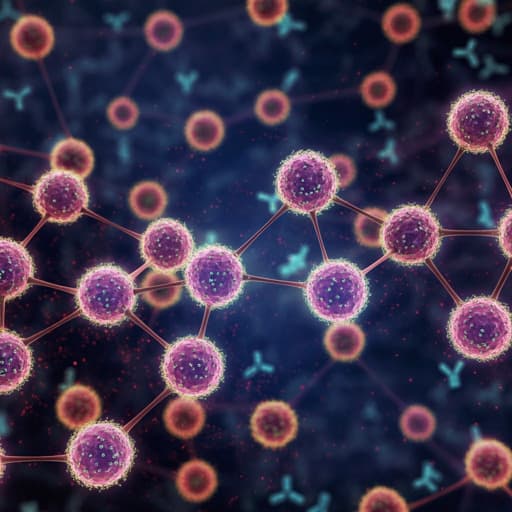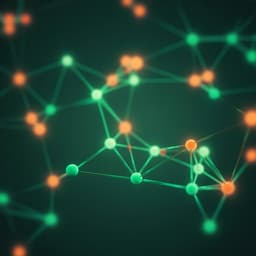
Biology
Prior SARS-CoV-2 Infection Enhances Initial mRNA Vaccine Response with a Lower Impact on Long-Term Immunity
Silva-moraes, Souquette, et al.
This study reveals intriguing insights into the adaptive immune responses generated after three doses of the Pfizer BNT162b2 mRNA vaccine in both SARS-CoV-2-naive and preimmune individuals. Conducted by Silva-Moraes, Souquette, A Sautto, Ida Paciello, Giada Antonelli, Emanuele Andreano, Rappuoli, Andr M Ea Teixeira-Carvalho, and DrTed M Ross, it highlights how prior infections significantly influence antibody levels while emphasizing the overall immune memory after vaccination.
~3 min • Beginner • English
Introduction
The study addresses how prior SARS-CoV-2 infection (preimmunity) shapes the magnitude, quality, and durability of adaptive immune responses elicited by repeated Spike-encoding mRNA vaccination, and whether repeated antigen exposures (through vaccination) differentially impact humoral and cellular immunity over time. In the context of widespread hybrid immunity and multiple vaccine boosters, the trajectory and longevity of IgG antibodies, memory B cells, and T cell responses remain incompletely understood. The purpose was to longitudinally compare immunologically naive versus previously infected individuals across three doses of Pfizer BNT162b2, assessing how priming by infection affects early vaccine responses and long-term immune memory. This is important to inform booster strategies, understand correlates of durable protection, and clarify the relative contributions of humoral versus cellular compartments in sustained immunity.
Literature Review
Methodology
Study design and cohort: Forty adults (22–65 years) from the SPARTA program (Athens and Augusta, GA; Memphis, TN; Los Angeles, CA) were enrolled starting October 2020 with IRB approval (WCG IRB no. 202029060). Nineteen were previously infected with SARS-CoV-2 (Wuhan wave, infections July 2020–January 2021; samples ≥180±65 days post-symptom onset before vaccination), and 21 were immunologically naive (no prior infection by PCR/self-report/anti-RBD Ab). All received three doses of Pfizer BNT162b2 monovalent mRNA vaccine with no breakthrough infections reported and no chronic health conditions.
Sampling timeline: PBMCs and sera were collected at six time points: T0 (prevaccine baseline), T1 (~30 days after dose 2), T2 (~90 days after dose 2), T3 (~180±65 days after dose 2), T4 (~30 days after dose 3), and T5 (~180±65 days after dose 3).
Sample processing: Serum separated, heat-inactivated (56°C, 45 min), stored at −80°C. PBMCs isolated using BD cell preparation tubes, RBC lysis, cryopreserved in 90% serum + 10% DMSO in liquid nitrogen.
Assays:
- ELISA for anti-RBD IgG binding using RBD (USA/WA1/2020 Wuhan-Hu-1; BEI NR-52309); detection by HRP anti-human IgG; OD414 reading; quantitation via 7-point human IgG standard curve; duplicates.
- Live-virus neutralization (cytopathic effect-based) against ancestral Wuhan strain (SARS-CoV-312 2/INMI1-Isolate/2020/Italy: MT066156) at BSL-3; sera tested from 1:10 in 2-fold serial dilutions; duplicates; positive/negative controls per plate; endpoint titers recorded.
- B cell FluoroSpot (after 5-day polyclonal stimulation with R848 + IL-2) to enumerate Spike- and RBD-specific IgM/IgG/IgA ASCs; Ag capture via anti-His-precoated wells loaded with 6×His-tagged full-length Spike (10 µg/mL) or anti-Igκ/λ for total Ig; 16 h incubation; automated spot counting.
- T cell peptide stimulation: 181 overlapping peptides (13–17-mers, 10 aa overlap) spanning full Spike (USA-WA1/2020; BEI NR-52402) at 1 µg/mL/peptide in DMSO.
- Activation-Induced Marker (AIM) flow assay: PBMC overnight rest; anti-CD40 block; Spike peptide stimulation 24 h; DMSO control; SEB and CMV pp65 as positive controls. AIM+ CD4 T cells defined as OX40+CD137+ (and for subset analyses OX40+CD40L+); AIM+ CD8 T cells defined as CD69+CD137+. SI = stimulated/unstimulated; SI>2 considered positive. Background (DMSO) subtracted with minimum 0.005%. Memory subset phenotyping via CCR7 and CD45RA (naive, CM, EM, TEMRA). cTfh identified as CXCR5+ within AIM+ CD4. Acquisition on NovoCyte Quanteon; Abs listed in Supplemental Table I. LOQ = mean of all negatives + 2 SD.
- Intracellular cytokine staining (ICS): PBMCs stimulated 18 h (brefeldin A and monensin added after 2 h). Surface staining including iCD40L for CD4; intracellular IFN-γ, IL-2, TNF-α for CD4 (CD40L+) and CD8. Boolean analysis for polyfunctionality. Background subtracted; LOQ as mean + 2 SD of negatives.
Statistics: Data presented as median and IQR. Mann-Whitney U for unpaired, Wilcoxon for paired. Kruskal-Wallis with Dunn’s posttest for ≥3 groups. χ2 for positivity rate. Spearman correlations for association analyses. FlowJo 10.7.1 for cytometry; GraphPad Prism 9.4 for statistics.
Key Findings
- Humoral responses:
- Binding anti-RBD IgG: Both groups developed robust responses after dose 2 and dose 3, sustained through T5. Preimmune had higher Ab concentrations at T1 vs naive (p=0.005). From T1 to T3, preimmune showed ~4-fold decline; naive showed ~10-fold decline with significantly lower levels than preimmune at T3 (p<0.0001). Dose 3 boosted both groups strongly (T3→T4, p<0.0001), with no significant difference at peak T4. From T4 to T5, modest decline (~1.5–2.5-fold) in both groups; sustained responses thereafter.
- Neutralizing antibodies (ancestral Wuhan): ~50% of preimmune had detectable neutralization at T0. After dose 2 (T1), 100% of preimmune and naive had neutralizing titers; naive then declined ~8-fold by T3 with lower positivity (42% at T3; p<0.001 vs preimmune). Naive T3 titers (median 10.42%) resembled preimmune T0 infection titers (median 15.54%). After dose 3 (T4), preimmune had higher neutralizing titers than naive; by T5, both showed ~2-fold decay with similar titers (p=0.11). End-of-study positivity was 100% preimmune vs 93% naive; median titers 400 vs 140, respectively.
- Memory B cells (ASCs by FluoroSpot):
- IgG Spike-specific ASCs detectable in 100% of preimmune at T0 and higher than naive (p=0.03). Dose 2 did not significantly increase Spike-specific IgG ASCs, whereas dose 3 significantly boosted IgG ASCs in both groups (naive p=0.005; preimmune p=0.031). RBD-specific IgG ASC trends mirrored Spike but at lower frequency. IgM ASCs showed minimal change after dose 2; ~70% had increases after dose 3. IgA ASCs were low at baseline in preimmune and not significantly boosted by vaccination; naive showed significant IgA increases after vaccination, with higher IgA RBD ASCs at T4 vs preimmune. Isotype composition shifted to predominantly IgG at T1 and maintained through T4 in both groups (∼78–95% of ASCs).
- CD4+ T cells (AIM):
- At T0, 74% of preimmune had detectable Spike-specific AIM+ CD4 T cells (higher than naive; p=0.01). Dose 2 induced detectable CD4 responses in all naive (median SI ~3.5), comparable to preimmune. Both groups exhibited slight drops by T3 (~1.5-fold). Dose 3 did not significantly increase peak frequencies but raised responder rates to 89–100%. By T5, ~2-fold contraction from T4 in both groups. After equivalent exposure counts, vaccine response time points did not differ (T1 preimmune vs T4 naive; p=0.350), but preimmune had higher responses at memory time points (T3 vs T5; p=0.002).
- CD8+ T cells (AIM):
- Few preimmune had detectable baseline CD8 (33% SI>2). Across doses, CD8 responses showed low magnitude boosts and returned toward baseline; ~25–50% positivity at peaks (higher after dose 3 for naive) and 13–25% at 6-month memory. No significant differences between groups at vaccine or memory time points.
- Memory subset phenotypes:
- CD4+ AIM+ cells were predominantly central memory (CM) at all time points. Preimmune had slightly higher effector memory (EM) fraction at T0 (28% vs 12% naive). Distribution remained relatively stable; at T5, preimmune retained a larger EM proportion than naive.
- CD8+ T cells were mainly EM and TEMRA; preimmune had 46% TEMRA at T0, while naive had 43% naive at T0. After dose 2, naive reached distributions similar to preimmune T0; preimmune maintained predominance of TEMRA over time.
- cTfh cells:
- Preimmune had ~2-fold higher Spike-specific cTfh at T0 (p=0.023). Dose 2 significantly boosted cTfh in preimmune (p=0.009) and levels remained higher than naive at T1 (p=0.014). No difference at T4; at T5, cTfh frequency again higher in preimmune (p=0.034) and correlated with binding and neutralizing Abs (p=0.043 and 0.039).
- CD4+ Th1 functionality (ICS):
- Preimmune had higher IFN-γ, IL-2, and TNF-α CD4 responses at T0; dose 2 further increased these (fold-changes: IFN-γ 2.1×, IL-2 1.6×, TNF-α 1.9×) to levels above naive. Naive showed strong induction after dose 2 (IFN-γ ~5.7×, IL-2 ~5.7×, TNF-α ~4.4×). By T5, both groups declined but remained above detection. Polyfunctionality: preimmune T0 had 42% producing ≥2 cytokines and 15% all three; naive reached similar after dose 2. By T5, both groups largely monofunctional (~75%).
- CD8+ functionality: Low frequencies of IFN-γ, TNF-α, IL-2 producers in both groups without significant differences; ~25% produced two cytokines and ~2% three across time.
- Correlations: Early AIM+ CD4 T cells (from infection at T0 or post-dose 2 at T1) correlated with later neutralizing titers (up to T5), indicating early CD4 help as an indicator of long-term humoral responses.
Overall: Prior infection enhanced early vaccine-induced humoral immunity and specialized CD4 responses (cTfh, EM, Th1) but conferred minimal advantage at long-term memory after three doses; repeated Spike exposure substantially improved antibody quantity/quality with modest impact on T cell magnitude/longevity.
Discussion
The study demonstrates that while repeated Spike-focused mRNA vaccination substantially augments humoral memory (higher IgG magnitude and neutralizing activity with improved durability after a third dose), it confers comparatively limited incremental gains in T cell frequencies and long-term cellular positivity rates. Pre-existing immunity from prior infection enhances initial vaccine responses—higher early neutralizing titers, elevated cTfh frequencies, stronger Th1 functionality, and a more effector-skewed CD4 memory phenotype—thereby accelerating and amplifying early adaptive responses. However, this advantage diminishes over time such that, by six months after the third dose, naive and preimmune individuals show similar overall memory quality and quantity. The observation that early induction of Spike-specific CD4 T cells correlates with subsequent neutralizing titers underscores the central role of CD4 help (particularly cTfh) in shaping durable humoral immunity. The predominance of CM CD4 memory suggests potential for long-term persistence, while the EM/TEMRA bias in CD8 memory reflects limited expansion and maintenance via repeated Spike-only boosting. These findings inform booster strategies by emphasizing that additional doses primarily enhance humoral durability, with cellular benefits plateauing, and that infection-primed enhancements are most prominent early after priming but do not markedly alter long-term equilibrium after standardized boosting.
Conclusion
This work characterizes the longitudinal trajectory of humoral and cellular immunity across three doses of BNT162b2 in naive and previously infected adults without breakthrough infections. Key contributions include: (1) repeated Spike exposure markedly boosts antibody magnitude and durability, especially after the third dose; (2) T cell responses exhibit modest boosting with limited long-term increases in frequency; (3) prior infection augments early vaccine responses—neutralization, cTfh, Th1 functionality, and effector memory—but yields minimal long-term advantage after three standardized exposures; and (4) early CD4 T cell induction correlates with later neutralizing titers, highlighting cTfh/Th1 as hallmarks of quality humoral memory. Future research should assess: heterologous or multivalent antigens (including non-Spike proteins) to broaden and sustain cellular immunity; mucosal immunization strategies to enhance tissue-resident immunity; optimized dosing intervals and adjuvants to improve T cell magnitude/persistence; and real-world effectiveness against variants, integrating tissue-level immune readouts.
Limitations
- Peripheral blood PBMCs may not reflect immune dynamics at the respiratory mucosa or secondary lymphoid tissues; antigen-specific cells may traffic out of circulation after activation.
- Peptide stimulation assays may underestimate epitope-specific T cell frequencies due to background and assay sensitivity; full-length Spike stimulation may obscure recall of non-Spike specificities generated by infection.
- Cohort size is modest (n=40) with predominantly white participants; generalizability may be limited.
- Only ancestral Wuhan strain was used for neutralization; breadth against variants was not assessed longitudinally in this study.
- Observational window to 6 months post-third dose; longer-term durability beyond this was not evaluated.
Related Publications
Explore these studies to deepen your understanding of the subject.







